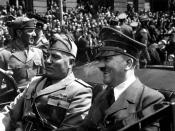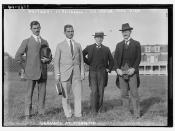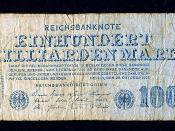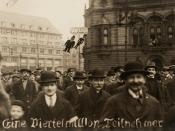At the end of World War One, political turmoil raged throughout Germany. With the morale and spirit of all Germans shattered, many political groups pressed their claims to a country that was on the brink of revolution. As a consequence, a period of instability and unrest followed and many attempts were made to overthrow the government.
On the 29th October 1918, a mutiny broke out at the Kiel naval base when angry sailors refused to put to sea. This unrest sparked a widespread revolt, which spread to other naval bases and inland to the strategic rail centre of Cologne. On the 7th November 1918 revolution in Munich led to the collapse of the Bavarian monarchy, as a result a republic was proclaimed by Kurt Eisner, leader of the USPD. With the Kaiser rejecting all requests to abdicate, the army announced that it would no longer serve under him. With support for the Kaiser dwindling, Chancellor Prince Max announced the abdication of the Kaiser.
Prince Max himself subsequently resigned, leaving Friedrich Ebert as Chancellor. It was at this time that Germany was declared a republic.
With the formation of the republic, there were immediate threats of a left-wing uprising. Ebert was forced to rely heavily on the army and the Freikorps, a volunteer band of soldiers and officers, to keep order in Germany. The military leadership itself feared the threats from the left, General Groener of the German High Command made a pact with Ebert. The pact gave Ebert the support of the army, providing protection for the republic. Groener, who did not want to see the disintegration of his army, was given a long-term assurance that the army would retain its influence and would become an integral political force in the future.
In January 1919, forces from the extreme left, the spartacists, who were opposed to moderate parties and Ebert, staged an uprising. Encouraged by the size of the working class, the Spartacists sought to seize power. The Spartacists, who declared themselves a communist party, seized a number of buildings and ordered the Ebert led government to fold. However, with the army on its side the Friekorps brutally crushed the revolt. The Friekorps were particularly brutal to Rosa Luxemburg and Karl Liebnecht, two figures that supported the uprising who were murdered.
The events that conspired in Berlin spread to other German cities such as Bavaria. Communists and radical workers once again featured in the uprising. Once again the Friekorps were sent to suppress the uprising. Kurt EisnerÃÂs USPD party was defeated in elections for the Bavarian parliament, and a few days after this Eisner was assassinated. These events triggered political chaos, and despite the futile situation that the communists were placed in, Bavaria was claimed to be a communist republic. The Friekorps were once again brutal in their methods of suppression, with five hundred people killed in the space of two months.
The events that took place in 1919 were a significant feature because they were the first attempts of counter-revolution. One repercussion was the hatred that now existed between the SPD and USPD. The parties of the extreme left would never forget how the moderate socialist used right-wing military groups to suppress uprisings, this caused enormous distrust between the two parties which would exist forever.
In 1920, the republic faced a challenge not from the left but this time from the right, known as the Kapp Putsch. Right wing parties never accepted the republic, they believed that it highlighted GermanyÃÂs failure and humiliation in the war. When Germany attempted to carry out the military clauses of the Treaty of Versailles, unrest grew, as the German army was to be reduced in size and the Friekorps were to be disbanded. In March 1920, the government ordered the dissolution of the Ehrhardt Friekorps; the military in the city refused to comply.
Ebert once again expected the army to protect it from this challenge, however General von Seeckt, the leader of the army refused to do this. Von Seeckt and the army sympathized with the rebels, and the military commanders of the Putsch declared a new government under Wolfgang Kapp. However, the Kapp Putsch had little chance of success. It failed within a few days because of the defiance of the working class, who had no sympathy for rebels. Strikes were declared by workers and trade unions that were effective and paralyzed the city.
Although the Kapp Putsch seems insignificant, it had some important implications. Firstly, this was the first attempt to seize power from the right, and now the government had to be wary of both wings. Secondly, it demonstrated the weakness of the government, with Ebert and other officials forced to leave the city. Lastly, the government could no longer rely on the army to protect them from uprisings; the army was quickly becoming a state within a state. The position of the army was furthered strengthened when the army crushed rebels in the Ruhr. The army had no hesitation against suppressing these radicals, and the army was now becoming a much stronger political force.
In 1923 another putsch, this time staged in Munich, took place on the 8th of November. It was here that Adolf Hitler and the Nazi party made their presence felt. In this right-wing revolt, Hitler positioned six hundred armed stormtroopers outside the Munich beer hall. They announced the overthrow of the Bavarian republic and declared a new national government under General Ludendorff. Although crowds approved the leading military figures did not, and the Putsch failed, as it did not have the support of the army.
The years 1918 to 1923 were a time of political and economic instability for the Weimar republic. The government was constantly under attack from left and right wing groups who criticized it for betraying German national needs (the ÃÂstab in the back legendÃÂ). However stability and prosperity characterized the period following 1923, the ÃÂgolden yearsÃÂ of the German republic.
Modern history booklet, 'last wars' 2007


![[German vehicle tax registration issued to George Grantham Bain] (LOC)](https://s.writework.com/uploads/6/60390/german-vehicle-tax-registration-issued-george-grantham-bain-thumb.jpg)


